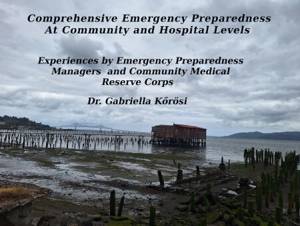
- Retrait gratuit dans votre magasin Club
- 7.000.000 titres dans notre catalogue
- Payer en toute sécurité
- Toujours un magasin près de chez vous
- Retrait gratuit dans votre magasin Club
- 7.000.0000 titres dans notre catalogue
- Payer en toute sécurité
- Toujours un magasin près de chez vous
Comprehensive Emergency Preparedness At Community and Hospital Levels Experiences by Emergency Preparedness Managers and Community Medical Reserve Corps EBOOK
Dr. Gabriella KőrösiDescription
Review by Dr. Frazier Beatty
In the face of an increasingly complex and uncertain world, the need for effective emergency preparedness has never been more critical. The past decade has witnessed a series of devastating disasters that have left communities reeling and underscored the importance of being ready to respond swiftly and effectively to crises, whether they be natural or man-made.
In the opening chapter of this book, Dr. Gabriella Kőrösi introduces us to a landscape marked by a litany of challenges. Tornadoes, influenza pandemics, floods, fires, anthrax attacks, terrorist acts, and disease outbreaks such as enterovirus and Ebola have cast a shadow over the United States in recent years. The numbers are staggering – over 300 major disasters recorded between 2010 and 2014, including 330 natural disasters globally in 2013 alone. These events encompass earthquakes, extreme temperatures, flooding, fires, hurricanes, severe storms, snowstorms, tornadoes, tsunamis, and more.
As the pages unfold, Dr. Gabriella Kőrösi delves into the specific vulnerabilities of Oregon, a state not immune to these threats. Flooding, landslides, bio-terrorism, drought, earthquakes, extreme heat, tsunamis, wildfires, windstorms, and winter storms are part of the unique challenges faced by this region. It is against this backdrop that the Emergency Preparedness (EP) Rule of 2016 came into effect, mandating healthcare facilities to ensure their readiness for emergencies.
The rationale for such rules becomes abundantly clear as the data is explored. Studies and reviews reveal disparities in preparedness across regions and healthcare institutions. Communication gaps, information-sharing deficiencies, and uneven levels of education and training all contribute to the challenges faced by healthcare professionals in preparing for emergencies.
In this book, Dr. Gabriella Kőrösi embarks on a journey into the heart of rural coastal communities in the Pacific Northwest. Through qualitative interviews, she gains insights from healthcare professionals who have grappled with the implementation of the EP Rule. The examination covers a multitude of factors, including communication, information-sharing, education, training, practice, metrics development, criteria development, and barriers.
The implications of this study are far-reaching. Not only does it shed light on the challenges faced by healthcare facilities, but it also serves as a clarion call for collaboration and communication between stakeholders in emergency preparedness. The potential societal impact is immense, with the promise of improved coordination, policy changes, enhanced training, and a deeper understanding of how hospitals in the region address emergency preparedness.
The chapters that follow delve deeper into these issues, providing valuable insights for healthcare professionals, policymakers, and anyone concerned with the safety and well-being of our communities. In a world where disaster can strike at any moment, this book is a timely and essential resource. It is Dr. Gabriella Kőrösi's hope that the knowledge contained within these pages will contribute to a safer, more resilient future for all.
Spécifications
Parties prenantes
- Auteur(s) :
- Editeur:
Contenu
- Langue:
- Anglais
Caractéristiques
- EAN:
- 9798231022847
- Date de parution :
- 07-08-25
- Format:
- Ebook
- Protection digitale:
- /
- Format numérique:
- ePub

Les avis
Nous publions uniquement les avis qui respectent les conditions requises. Consultez nos conditions pour les avis.






